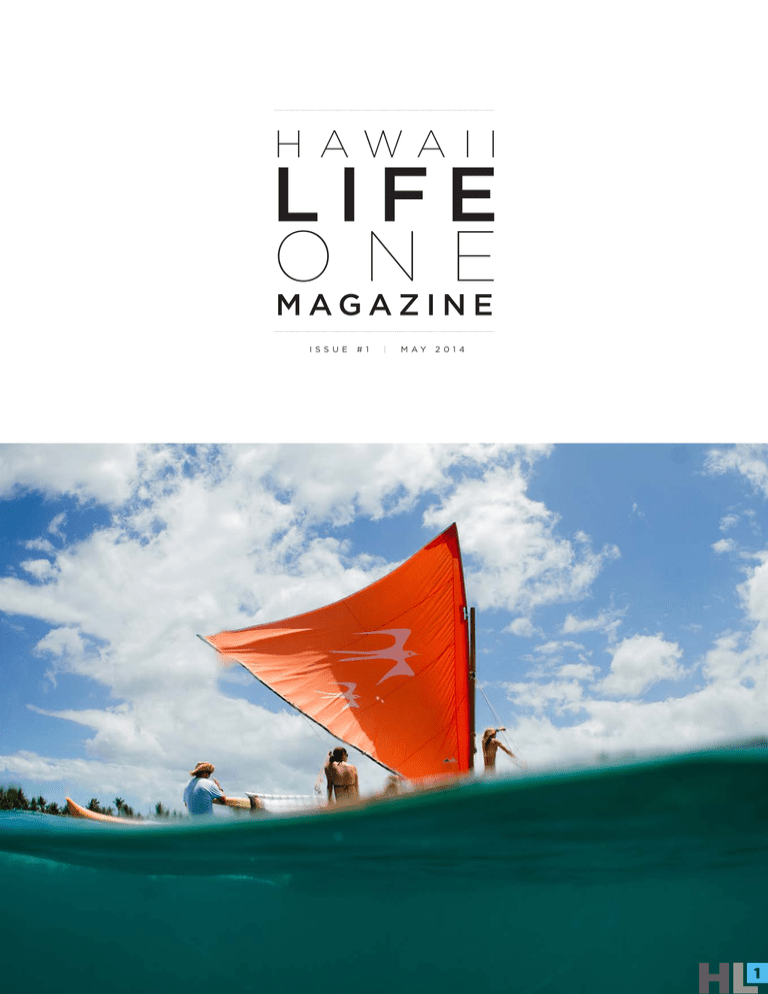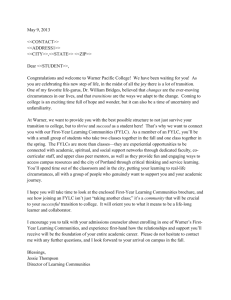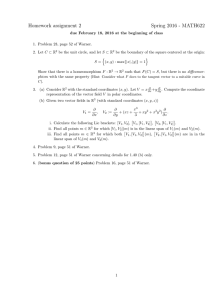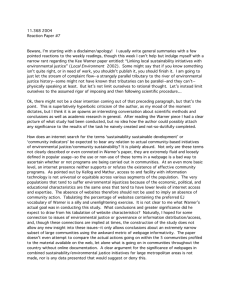Hawaii Life Magazine - Walker Warner Architects
advertisement

HAWA II LIFE O N E MAGAZINE I SSU E # 1 | 1 M AY 2 01 4 Welcome Aboard . . . . . . . . . . . . . . . . . . . . . . . . . . . . . . . . . . . . . . . . . 14 The HL1 Project. . . . . . . . . . . . . . . . . . . . . . . . . . . . . . . . . . . . . . . . . . . 15 Advancing Hawai‘i Modern . . . . . . . . . . . . . . . . . . . . . . . . . . . . . . . . 16 A Walk on the Wild Side. . . . . . . . . . . . . . . . . . . . . . . . . . . . . . . . . . . 28 Life + Sport + Art . . . . . . . . . . . . . . . . . . . . . . . . . . . . . . . . . . . . . . . . . 38 HL1 Curated Collection . . . . . . . . . . . . . . . . . . . . . . . . . . . . . . . . . . . 46 HL1 Team . . . . . . . . . . . . . . . . . . . . . . . . . . . . . . . . . . . . . . . . . . . . . . . . 47 Kauai . . . . . . . . . . . . . . . . . . . . . . . . . . . . . . . . . . . . . . . . . . . . . . . . 48–61 Big Island. . . . . . . . . . . . . . . . . . . . . . . . . . . . . . . . . . . . . . . . . . . . .62–69 Content. 3 39 0 STO R I E S P R O P E RT I E S N O ISE Maui . . . . . . . . . . . . . . . . . . . . . . . . . . . . . . . . . . . . . . . . . . . . . . . . . 70–75 Oahu . . . . . . . . . . . . . . . . . . . . . . . . . . . . . . . . . . . . . . . . . . . . . . . . . 76–78 More Information . . . . . . . . . . . . . . . . . . . . . . . . . . . . . . . . . . . . . . . . . 79 COV E R : C A N O E SA L I N G O N T H E B I G I S L A N D, P H OTO BY SA R A H L E E H AWA I L I F E O N E I S A S P E C I A L D I V I S I O N O F H AWA I I L I F E R E A L E S TAT E B R O K E R S 844.667.0111 | HL1.com E V E R Y T H I N G © C O P Y R I G H T 2 0 1 4 H AWA I I L I F E R E A L E S TAT E B R O K E R S 16 36 48 54 62 70 28 38 52 56 64 76 12 13 Advancing Hawai‘i Modern Fifty years ago, prolific Hawai‘i architect Vladimir Ossipoff declared a “War on Ugliness.” Present-day architect Greg Warner finds inspiration in Ossipoff’s legacy, and shares the vision to improve living through smart design. CONCEPT BY WINSTON WELBORN | WRITTEN BY JAMES CHARISMA AND RICHARD MELENDEZ IMAGES COURTESY MATTHEW MILLMAN PHOTOGRAPHY AND BOB LILJESTRAND 16 17 For Greg Warner, a principal and owner at Walker Warner Architects, there are three guiding design tenets applied to all projects… 1 CONTEXT Respect context and sensitivity to place. Buildings should be specifically suited to the place in which they are situated. Climate and other factors are incorporated within this context. 2 L I VA B I L I T Y Make it comfortable. Livable. Structures should not just be practical and functional, but meaningful with pleasing aesthetics that bridge the gap from ‘house’ to ‘home.’ 3 CRAFT Honor craft and materials. Walker Warner designs display vignettes of materials; expressions that are part of the architecture and not hidden from view. Whether it’s concrete, natural wood or steel, the firm’s designs seek to beautify and utilize it. Photos: Context and craft from recent Walker Warner projects on the Big Island. 18 19 W arner’s guiding principles and attention to these details and inspiration come from a lifestyle of experience and one archi- tect in particular—Vladimir Ossipoff, the legendary and influential architect who shaped a great deal of Honolulu’s look through the 20th century. His legacy continues today, in the works that still stand and in the influences he’s left upon those who’ve followed in his footsteps. Born in Russia at the start of the twentieth century, Ossipoff grew up in Japan, where his father served as a military attaché of the Russian embassy in Tokyo. At age 16, Ossipoff emigrated to the United States, ultimately graduating from the University of California, Berkeley, and moving to Honolulu at age 24. O ssipoff deliberately distanced himself from architectural elements of modernity, including the European avant-garde, and his eclectic career echoed many of his personal sentiments regarding architecture. He encouraged the development of structures based on the landscape around them, to fit appropriately with a building’s surroundings rather than ignoring it. “A building in Panama turns out the same as one in Alaska when architects begin ignoring the natural climate,” Ossipoff said in an interview with the Honolulu Advertiser in the early 1960s. According to Ossipoff, relying on modern technologies—like air conditioning—led to a tendency to ignore existing natural conditions, creating a kind of uniformity in architecture. Housing developments that looked identical bothered the architect, who understood that Hawai‘i’s high land values dictated a degree of conformity and resisted more open-ended types of construction. Photos: the Ossipoff-designed chapel at HPA, young Ossipoff at work. 20 21 I n the 1960s, Ossipoff declared a “War on Ugliness,” challenging and countering what he considered poor architectural designs, particularly within the unrestricted development of Honolulu. His architectural style stood apart from many traditional architectural elements of the time, favoring spacious interiors and timber roofwork, while maintaining an intimate feel. Ossipoff often designed details that revealed how joints and materials related and connected to one another. A natural wood finish, for example, or coarse plaster and exposed concrete were trademarks of his work on Liljestrand House in Makiki (1952), and Pauline House on Round Top (1957) as well as his own residences in Kuli’ou’ou (1958) and on Blanche Hill in Kahala (1961). Equal attention was paid to lanais as well as the procession leading to a structure’s front entrance. Other work utilized heavy reinforced concrete, to adapt to contemporary instrumental needs as well as to fit larger projects, such as the University of Hawai‘i at Manoa’s Administrative Building (1949) or his work on the IBM Building by Ward (1962) and the Kahului Airport Terminal on Maui (1966). His other notable works include designs for the Pacific Club (1959) and the Hawai‘i Medical Library (1961) in Honolulu, the Outrigger Canoe Club in Waikiki (1963), and a full transformation of the Honolulu International Airport from 1970 through 1978. Photos: Ossipoff’s Liljestrand House in the Tantalus Hills above Honolulu. 22 23 W arner grew up in Hawai‘i and, as a youth, attended the Ossipoff-designed Hawai‘i Preparatory Academy (HPA) on the Big Island. While he didn’t know who had designed the buildings or the school’s chapel, he recognized it as a unique place. The elements that Ossipoff incorporated in his own work would embed itself with Warner’s subconscious and ultimately prove to impact this architect-to-be, years down the line. Warner didn’t realize the effect Ossipoff’s designs had upon him until about ten years ago, during a conversation about architecture with Sam Ainslie. In the years since he was a student at HPA, Warner had moved away from Hawai‘i and continued his education at the University of Oregon, and built up his experience by working at various firms in the Bay Area. It was during a return trip to Hawai‘i, and an innocuous conversation with Ainslie about possibly designing his home that a connection to Ossipoff came to light. The two men spoke about Warner’s background and influences, which led to a discussion about the campus of HPA. Warner found himself using the school as a reference point while he discussed sensible architecture, which was a dialect that flowed easily and made perfect sense to him. Spaciousness. Incorporating a structure’s existing environment. Natural finishes. Ossipoff’s designs for HPA served as a touchstone for both Warner and Ainslie when the pair would begin working together to design the Ainslie residence: Hale Ma’alahi, in Kamuela. H ale Ma’alahi is situated on a crease between two distinct micro-climates. On its ‘wet side,’ the house forms intimate con- nections with lush rain forest descending to a gulch stream below. On its ‘dry side,’ it opens to expansive views and broad pasture lands surrounding Mauna Kea. The house responds to this dichotomy through its form – rising as it transitions from immediate to distant views as well as directing rainwater toward the natural watershed. The building is meant to breathe; the owners desired a naturally conditioned home, responsive to the weather. Durable materials such as locally sourced stone and an exposed cedar roof framing allow for a seamless transition from interior to exterior, and help stand up to the elements as air moves through custom jalousie windows. The work of local artisans, incorporating native materials such as ‘ohia columns, wind screening, and carved koa slabs, root the house in place-sensitive Hawaiian tradition. Photos: Walker Warner designed Hale Ma‘alahi in Kamuela and distant Mauna Kea. 24 25 I t’s this harmony of structure and natural setting that is an integral part of what Ossipoff – and the Walker Warner team – bring to their own designs. Warner explains that Ossipoff was an environmentalist before terms such as “green” and “sustainable” became the norm. He held to many of the ideals naturally, and didn’t require a movement to extol the virtues of sensible, environmental design. Many of Ossipoff’s contemporaries were, like Ossipoff, modernists, but their designs often skewed to the utilitarian. For Ossipoff, being utilitarian simply wasn’t enough, and he recognized a need to push beyond such designs. What Ossipoff did with his work was to try to capture a sense of endurance, to bring together craft, aesthetic, and sensibilities of place and person to create a legacy ideal; to build something that would stand the proverbial test of time. It’s a position that Walker Warner Architects have taken as well. “We’re creating new architecture, but it’s referential,” says Warner. “We try to design buildings that are forward leaning for a contemporary lifestyle. How we live now is different than previous generations.” Warner explains that today, for example, many rooms are less compartmentalized; people don’t dine formerly like they used to. Whether for eating, working, or relaxing, spaces tend to be merged together more. Fifty years ago, rooms were more compartmentalized. There is efficiency to that, but it also hinders a lot of potential expression in architecture—and in mindset. W hat Warner and his firm do strive to achieve is to be the “Patagonia of Architecture.” Patagonia, the designer of outdoor clothing and gear, produces products that are practical, functional, and timeless. They don’t chase after trends; they’re just well made. “When you get that one piece, that one pair of gloves, you cherish it. Even if it gets worn out, it has great value to you,” Warner says. How are families going to live ten years from now? How are technology and culture influencing how people use their living spaces? These are factors that Walker Warner Architects try to envisage. Lifestyles evolve, and these potential changes should be taken into account when designing a new home. “It’s not my intention to create a new vernacular, or a new piece of residential architecture in Hawai‘i,” says Warner. “It’s happening naturally. And if whatever I do catches on, so be it.” For more information on San Francisco based Walker Warner Architects visit walker-warner.com. Photos: Hale Ma‘alahi, Greg hanging out. 26 27




